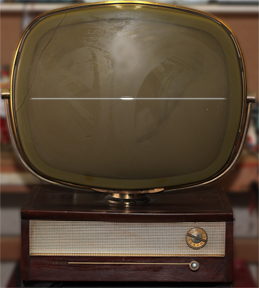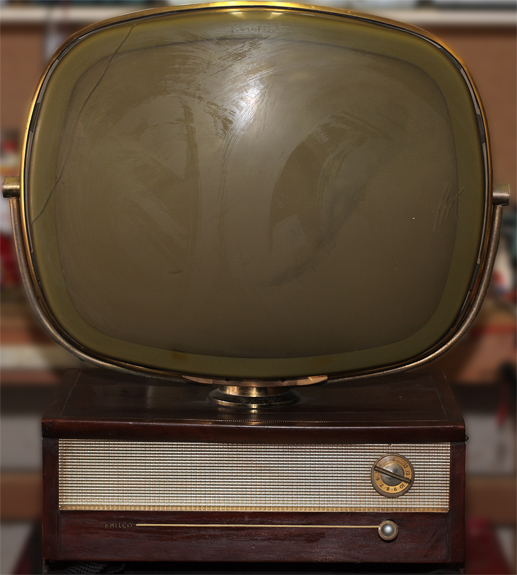Purchased because it was cheap, which is mostly due to that big crack on the front mask and general cloudiness, which makes it look like the picture tube is broken. Happily it isn't; it's just the mask and I got a replacement, which needs to be cleaned and fitted.
I'm surprised that I haven't been able to find out too much about them. There are a lot of images of them on the internet because this is the television equivalent of a Philco cathedral radio. (The word is heavily mis- and overused these days, but Predictas truly are icons.) While I've seen bits and pieces, like Phil's restoration of a pedestal model, I haven't found anything that offers a timeline with model dates, names, numbers, and features.
I did find this, however, from the fantastic American Radio History site, in the April 1961 issue of Television Digest:
Saga of Philco's Predicta: Philco's Predicta TV sets, which debuted in 1958 (Vol 14:23 p10) and were buried the following year, were cited April 5 by a Wall Street Journal article on fanfared products that have fizzled.
"If distinctive appearance guaranteed brisk sales, the Predictas seemed destined for success," noted the publication. . . .
"But the public apparently was unimpressed. Though an initial burst of dealer enthusiasm led Philco to double production at the start of 1959," the account continued, "orders began to dwindle by the middle of that year. They kept falling, and last year—long before such a basically revamped product line could normally be expected to expire—Philco stopped shipping Predicta models to dealers. The Predicta line, for which Philco had exceeded developed & retoolling budgets by 25% and on which profts had been negligible, was clearly a flop."
From the same article, they quote a Philco V.P. as blaming too high a price and too extreme a design. "People said the sets were nice to look at, but they wouldn't want to have them in their homes."
Subsequent issues of Television Digest mention that Philco found a market selling them to hotels for in-room TVs, where the swivel screen and the ability to build them into furniture was an asset.
The article just above this one mentions Philco having a "disappointing and difficult" 1960 and went into the red in Q1 of 1961. The glory days were definitely over.
Model: G4242 (suffix letter designates cabinet style; U-prefix is a UHF model)
Chassis:
9L37 (U-suffix designates UHF tuner included)
Picture tube: 21EAP4 / SF21A
Tubes:
- 3BZ6 - 1st and 2nd video IF amp
- 5AM8 - 3rd video IF amp / video detector
- 6AW8A - video output - noise inverter
- 3AU6 - sound IF amp
- 3BN6 - audio detector
- 12CA5 - audio out
- 9BR7 - sync separator - horizontal AFC
- 10DE7 - vertical multiplier - vertical out
- 6CG7 - horizontal multiplier
- 12DQ6A - horizontal out
- 12D4GT - damper
- 1G3GT/1B3GT - high voltage rectifier
- 4BC8 - RF amp
- 5X8 - mixer / oscillator
- 2AF4A - UHF oscillator
Service docs - Beitman's: TV-13, pp. 110 - 116
Service docs - Sams Photofact: 439-1
The Old Man was interested in looking it over, and I know nothing about televisions other than how to watch them. I'm old enough to be familiar with the fine tune, horizontal- and vertical-hold knobs, and separate VHF and UHF dials. But I don't know a flyback transformer from a DC restorer from B-plus-Boost. I know enough to be very careful of high voltages.
I checked the filament on the picture tube, because if that's blown, we may as well stop right there; but I got continuity. I pulled the chassis and checked the tubes, then replaced a couple duds. The Old Man looked over the chassis, replaced the blown fusable resistor (made one out a 10W resistor and a 1A fuse), checked the thermistor and the filter caps and a few other items. We cabled everything back up and fired it up. It's transformerless, so the tubes are all in series and if one goes, nothing works; the set lit up. Got high voltage off the rectifier. No picture.
 |
What a horizontal raster might look like |
Round 2 (Fall 2018) . I picked up a B&K 465 CrT tester and hope it may prove whether the jug is truly good or not. It's weak but it works. I had an offer of another jug for $300, but decided to try a picture tube brightener instead, which was $15. If I were going to use this set all the time, I would have bought the good tube. But considering its future running life is probably less than 10 hours,
Round 3 (Spring 2019):. I bought a parts chassis and a replacement picture-tube mask. The parts chassis came in very handy, since the Old Man could compare them (someone had worked on the original Predicta and made some questionable fixes), and could prod and turn and look at things on the parts chassis while the main chassis was hot.
TV is way over my head, so the old man made a number of fixes and tests that I did not record, and was able to bring up horizontal sweep, which provided high voltage. That gave us a horizontal line on the jug. That's a lot farther than we'd been before. It also told us that we don't need the tube brightener gimmick afterall.
No vertical, though. We're stuck again. The old man had given me his test equipment and components, so next time I have to bring a handful of capacitors, my substitution box, a couple of tubes, and a couple of tube test sockets so we can take meter readings from the top of the chassis (some of the tubes socket bottoms aren't visible from underneath). And I still have to clean the new mask.
Round 4 (Late Spring 2019): the 9-pin test socket paid for itself by helping diagnose whacky voltages on the 10DE7 vertical out tube. One of the .1 uF 400V caps (C36 on the SAMS photofact), the type I call a bumble-bee because it's almost black with slim, brightly colored concentric bands, had gone bad. The Old Man said those types were notorious for going bad; Webcor liked to use them and he replaced a ton of them. It had already been replaced on the parts chassis, so we took that one off and used it.
Now we got vertical. The Old Man is still not happy with the high voltage level, but now we got a fairly bright, flickering image. Some fiddling with the controls, and the Old Man declared that we have no sync. So that will be where we pick up next time.
Round 5 (Spring 2020): The Old Man passed away early this year, so nothing new on the set. Didn't get to work on it over the holidays because the workshop (aka garage) was too cold for comfort. We did talk about it a little, and he suggested that what might be left is to adjust the vertical. He seemed to think that might do the trick.
Unfortunately I haven't had an opportunity to do anything with it. I've been consolidating our stuff, and my workshop looks like a storage locker after an earthquake. Meantime the set is still at the house. I've tried twice now to fetch it but ended up with carloads of other stuff with a higher priority. I hope to have the bench cleared off this spring, bring the TV home, try to reassemble it and adjust the vertical, and hope that does the trick.. I'll update when I do.
Last day of Spring, 2020: the Predicta is home.
July: used plastic polish to clean the mask as much as I dared, both inside and out. A lot of the haze is now gone. Bought a gold ink pen and carefully inked in the Philco Predicta etching on the top of the mask. The letters are slightly etched so it was a bit more tolerant of my shaky hand than freehanding.
August 9: the old, cracked masked has been removed, the picture tube surface cleaned, the new mask installed and the gold trim reinstalled (a guy on youTube was right: it is a pain it the ass). Mounted the tube back on the cabinet and the cables are snaked in.
June 2020: chassis is back in, bottom grill and legs bolted back on. The last missing knob and a replacement cheater cord arrived (thank you, Tim). Got everything together and fired it up—no picture. Not even a raster.
I don't know what I'm doing, so it's now just going to be a non-working display. Maybe someday I'll get someone who knows antique TVs to take a shot at it. But since I wasn't planning on running it for anything more than occasional demonstration, it's a very low priority.
Current Status: no picture..


